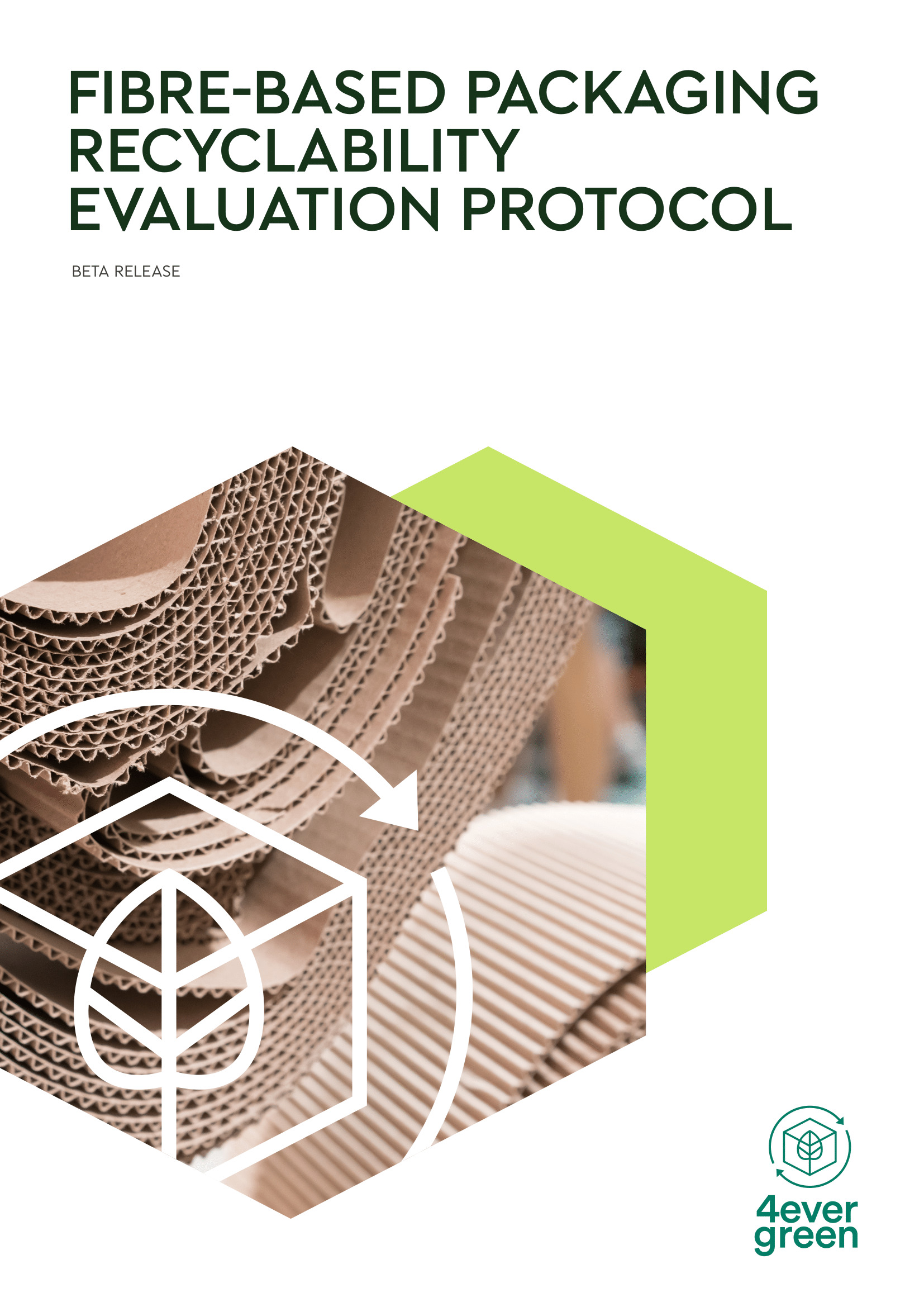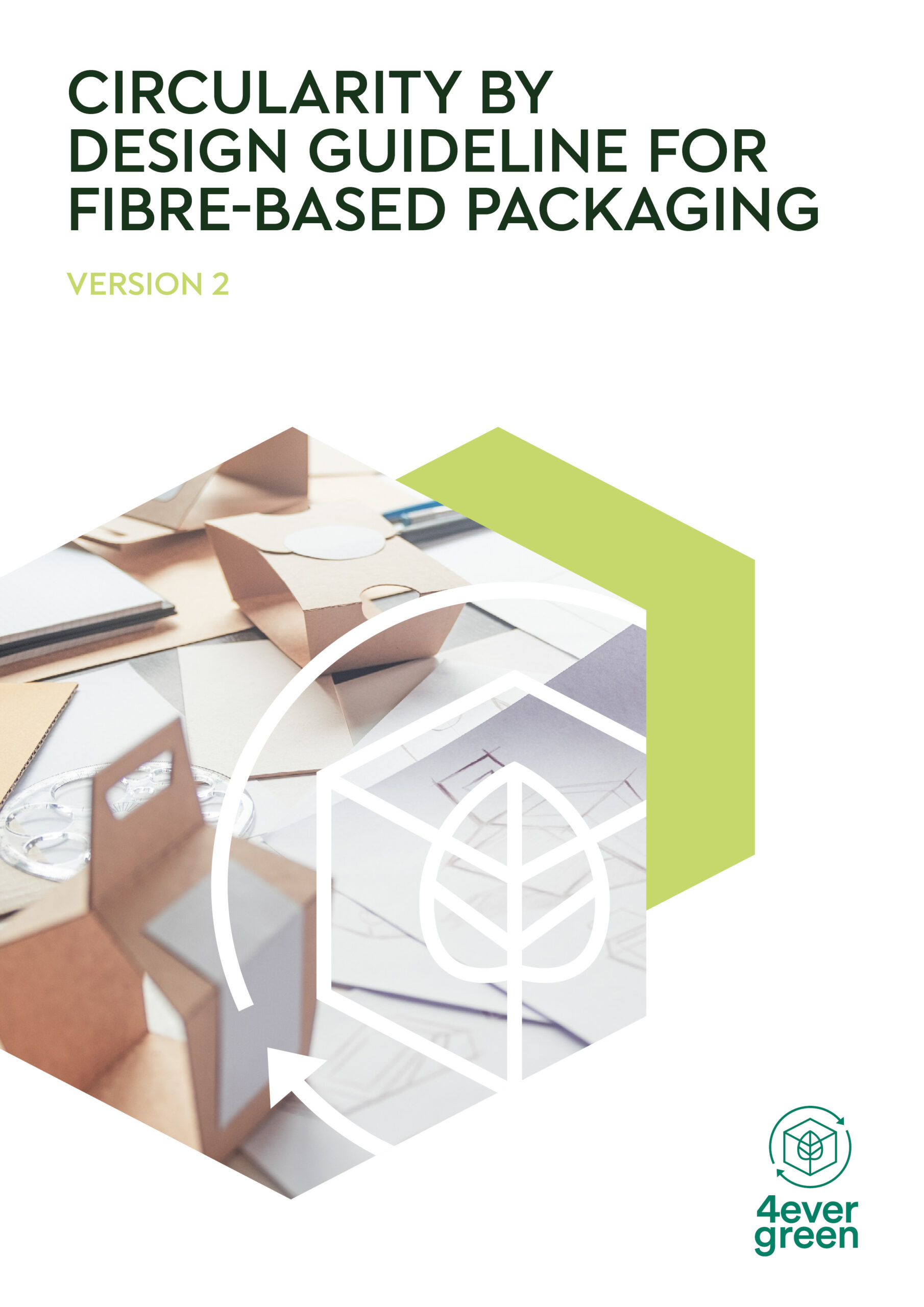At the 4evergreen alliance, more than 380 experts from across the fibre-based packaging value chain collaborate to develop expert knowledge and science-based guidelines and recommendations for fibre-based packaging that is compatible with a low-carbon, climate-neutral society.
Each technical workstream has already made significant contributions to improving the circularity of fibre-based packaging at each stage of its life cycle. Here, you will find the reports, protocols, and guidelines released. Each is the culmination of science-led research and expert discussions.
As a starting point, the alliance focused on ‘standard’ mill capabilities, addressing the largest chunk of fibre-based packaging. However, the latest developments have been incorporated to include recommendations for fibre-based packaging that require reprocessing in deinking and specialised recycling facilities. These living documents will be updated as industry knowledge progresses.
Recyclability Evaluation Protocol
The Recyclability Evaluation Protocol is a harmonised industry tool for assessing how efficiently fibre-based packaging materials can be recycled into usable raw material, taking into account the different recycling technologies in place across the EU. It aims to be accepted and used by the fibre-based packaging value chain as the go-to assessment tool for recyclability in Europe.
The protocol’s Part I (December 2022) is available and can be used to evaluate individual fibre-based packaging products and score their suitability for recycling in standard recycling mills.
Recyclability Evaluation Protocol (2022)
According to the protocol, the recyclability evaluation of a paper and board packaging product in a standard mill follows these next steps:
Step 1: assessment starts with running a laboratory recycling test of the packaging, according to the Cepi Recyclability Laboratory Test Method (Version 2). This method is crucial as it allows the most relevant stages of a standard mill recycling process to be mimicked in a harmonised way.
*To understand more about the testing method, you can find here a Detailed Work Description, a Lab Report Template, and a ‘Decision Tree’ to assess visual impurities. You can also find this List of laboratories that can test paper products according to Cepi recyclability laboratory test method.
Step 2: The test results will provide data along key parameters (e.g., yield, visual impurities, sheet adhesion, etc.), indicating how suitable the packaging material is for a standard recycling mill process.
Step 3: The data set can then be inserted into an Excel scorecard template for processing. The tool will return scores for each individual parameter and an overall recyclability score and assessment for suitability for standard mill recycling. The higher the score, the better the recyclability in a standard recycling mill.
Stay tuned for a complete Recyclability Evaluation Protocol, incorporating:
- Part II on Recyclability evaluation in flotation-deinking mills (expected Q4 2024)
- Part III on Recyclability evaluation in specialised mills (expected Q4 2024)
'Circularity by Design' Guideline
The Circularity by Design Guideline offers precise recommendations to packaging designers and producers on creating fibre-based packaging solutions that are designed for recycling from the beginning. As a result, the document serves as guidance for choosing suitable materials and processes that assure the quality of the recycled fibres.
Design recommendations – divided into Parts I, II and III of the guideline – are based on the compatibility of different materials and components with different recycling processes:
- Standard recycling mills (Part I)
- Flotation deinking recycling mills (Part II)
- Specialised recycling mills (Part III)
Circularity by Design Guideline (2023)
The current Circularity by Design Guideline (June 2023) provides design recommendations for fibre-based packaging products likely to be recycled in standard mills (Part I), and for used beverage cartons (UBC) and other complex packaging of similar composition that require recycling in specialised mills (Part III).
The guideline includes a decision tree, showing users the relevant type of recycling mill in which the assessed packaging should be recycled.
Stay tuned for a complete Circularity by Design Guideline, incorporating:
- Recommendations on the suitability of packaging materials in flotation-deinking and additional specialised recycling processes (expected Q3 2024)
Guidance on the Improved Collection and Sorting
‘The Guidance on the Improved Collection and Sorting of Fibre-based Packaging for Recycling’ is based on a state-of-the-art review of the institutional frameworks and different collection and sorting systems in European countries.
It provides recommendations to guide the implementation of the future collection, sorting, and recycling infrastructure to meet EU legal requirements and achieve 4evergreen’s ambitious targets, including a 90% recycling rate for fibre-based packaging.
Guidance on the Improved Collection and Sorting of Fibre-based Packaging for Recycling (December 2023)
First released in 2022, the current guidance (December 2023) has been subject to external consultation to incorporate the latest industry findings and reinforce the recommendations for effective collection and sorting practices across Europe.
The Guidance focuses on household collection, and recommends collection and sorting in two co-existing streams for paper & board (PB) and lightweight packaging (LWP).
It therefore empowers consumers to recycle effectively by using two separate streams:
- The ‘blue bin’ for paper, board, and fibre-based packaging for standard and deinking paper mills.
- The ‘yellow bin’ for specific packaging types, like used beverage cartons and fibre-based composite packaging, requiring specialised paper mills.
Stay tuned for a complete Guidance on the Improved Collection and Sorting, which will include new chapters on:
- HORECA (hotel /restaurant/catering) and on-the-go packaging
- Impact on residual foodstuff
- Specialised mills capacity mapping
- Deep-dive on sorting
The final Guidance publication is expected for Q4 2024.



